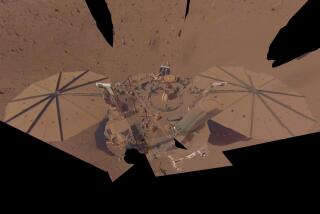Could Mars have supported life after loss of thick atmosphere?
NASAâs Mars 2020 rover, charged with looking for past life on the planet, probably wonât be finding any signs of current â or even recent â activity, if the Curiosity roverâs discoveries are any indication. But scientists for the Mars Science Laboratory rover have shown that the Red Planetâs atmosphere was much thicker in its early history than it is today â which could have provided a window of opportunity for life to come into existence.
The findings published in the journal Science looked at the isotopic ratios of carbon and argon, among other elements. An isotope is a version of an element with a different number of neutrons â for example, carbon-13 has one more neutron than carbon-12, making it heavier. Comparing the abundance of the heavy versions to the lightweight ones, they found that many of the lighter versions were missing â which told them that much of the atmosphere had escaped into space, a long time ago. (Hereâs more on their two studies.)
Marsâ protective magnetic field probably faded early in its history, leaving it exposed to the sun. The late heavy bombardment that hammered the planets with debris roughly 4 billion years ago would have also stripped the atmosphere, said Paul Mahaffy, lead scientist on the Sample Analysis at Mars instrument in Curiosityâs belly.
Still, itâs possible that life could have developed earlier in Marsâ history, with a thicker atmosphere â and then the hardiest of microbes could have roughed it with the water and organic molecules still available, even after the air grew thin.
âHow much do we really know about how â as those conditions changed, as Mars got colder and as the atmosphere got thinner â how life might have adapted?â Mahaffy said.
Curiosity is finding plenty of evidence that there were habitable environments with organic chemicals and running water about 3.5 billion years ago, Mahaffy said.
And Mars may have even had a northern ocean measuring nearly 39,000 square miles, according to a recent study in the Journal of Geophysical Research. Using the Mars Reconnaissance Orbiter, which can pick out features as small as 25 centimeters long, scientists tracked sediment deposits apparently left in a fan-shaped bed, concluding that they may have formed a delta feeding into a massive ocean.
[For the record, 9:36 a.m. July 20: An earlier version of this post referred to a possible Martian ocean as 39,000 miles wide. It is 39,000 square miles.]







